
May 15 marked Astronomy Day in the spring of 2021. No scientific expertise or knowledge of the universe’s history is necessary to partake in the celebration. Simply having an appreciation for the mesmerizing beauty of the night sky and taking the time to enjoy it is sufficient. However, for those who desire more than just admiration, the editorial team at MagadanMedia, citing the online magazine Meteoweb.ru, has compiled an astronomical cheat sheet to assist in locating six prominent constellations in the nocturnal expanse.
Locating the Big and Little Bears (“dipper” and “small dipper”)
How to locate the Big Dipper
This constellation can be found in the northwest during the summer, north in the fall, northeast in the winter, and directly overhead in the spring.
How to locate the Little Dipper
To locate the Little Dipper, mentally draw a straight line through the two outermost stars of the Big Dipper (refer to the figure below). The line should intersect with the first star, which has a similar brightness to the stars in the “bucket” – Polaris. Polaris is located in the “tail” of the Little Dipper constellation. Once you have found Polaris, you can easily locate all the other stars in the “small bucket”.
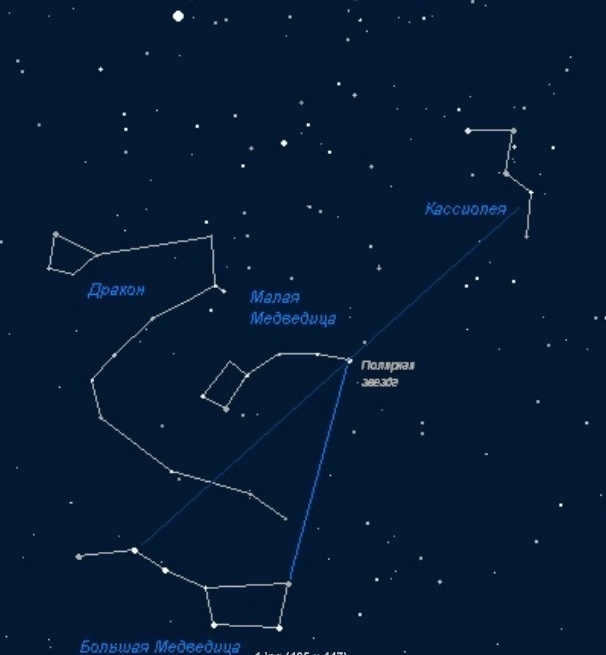
Constellations. Photo: meteoweb.ru
Cassiopeia and the Dragon
Locating Cassiopeia
Observe the second star from the end of the handle of the Big Dipper, known as Mizar (see the image below). Visualize a straight line extending from Mizar through Polaris and continuing for the same distance. You will encounter a radiant constellation resembling the letter W, which is Cassiopeia.
Locating the Dragon
This constellation is positioned between the Big Dipper and the Little Dipper. To find it, simply identify the two “buckets”.

Constellations. Picture: meteoweb.ru
The Great Bear, the Little Bear, Cassiopeia, and the Dragon are constellations that can be found in the Northern sky. These constellations are particularly visible in the European territory of the former USSR due to their proximity to the North Pole. One interesting feature of these constellations is that they do not set, meaning they can be seen throughout the night.
Lyra and Cepheus
Locating Lyra
To locate the constellation Lyra, you can look for the brightest star in the northern hemisphere of the sky, Vega. In September and August, Vega is highly visible above the horizon in the southwestern and western parts of the sky. Vega is positioned near the “head” of the constellation Draco, which is made up of four trapezoidal stars.
You can draw an imaginary straight line from the outermost star of the Big Dipper (known as Dubhe) through the head of Draco (refer to the image below). Vega will be found along this line, accompanied by several faint stars that form a shape resembling a parallelogram. This is the constellation Lyra.
Locating Cepheus
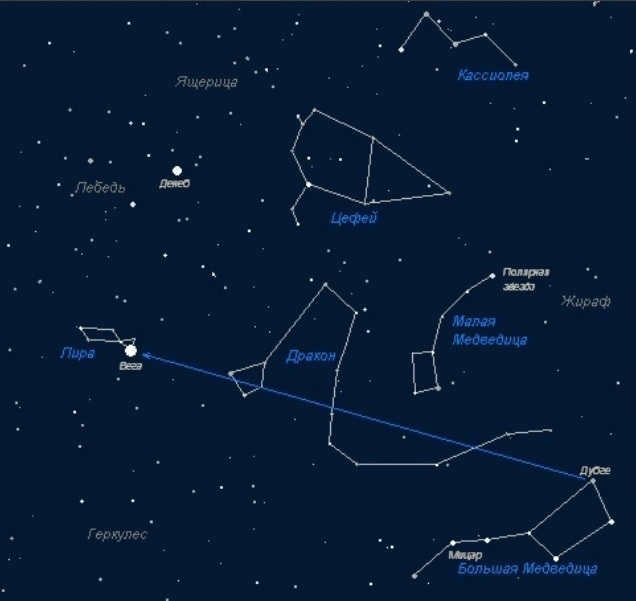
Constellations. Photo: meteoweb.ru
Cepheus is one of the constellations located near the North Pole, and the brightest star in the northern hemisphere of the sky is Vega, which is part of the Lyra constellation.
The Day of Astronomy was created by an American named Doug Berger, who was an enthusiastic amateur astronomer. His goal was to make astronomy more accessible to the general public and introduce as many people as possible to it. In 1973, Berger and his friends set up multiple telescopes at a busy intersection in a city, attracting a crowd of curious onlookers. The idea of popularizing astronomy was well-received, and as a result, this holiday eventually gained national and international recognition.
This material was prepared based on beginner’s astronomy lessons by O. Malakhov. Malakhov, source: Meteoweb.ru.
In the evening of mid-January, the winter constellations – Orion, Taurus, Gemini, and Ascendant – shine brightly in the southern side of the sky. The starry sky in winter is remarkably vibrant and captivating. It is adorned with seven first magnitude stars that are clustered together, creating a mesmerizing spectacle that can be easily observed with a single glance. No other season offers such an abundance of bright stars in the sky. That is why winter is the ideal time to begin exploring and familiarizing oneself with the celestial wonders above. You are sure to be amazed and enchanted by the beauty and vastness of the winter night sky!
What is the winter night sky like?
Before we delve into the details of winter constellations, I want to emphasize one crucial point. This article will focus solely on the southern hemisphere of the sky. The winter night sky refers to the portion of the sky visible in the southern hemisphere during winter evenings..
The reality is that in Russia, the winter nights are exceptionally long. (Beyond the Arctic Circle in December-January, the Sun remains below the horizon throughout the day!) Throughout these extended nights, the sky undergoes nearly a complete revolution, revealing to us the various stars and constellations of the different seasons. During the early evening hours, one can observe the autumn constellations high in the sky, while in the evening and the first half of the night, the winter constellations dominate. In the late hours of the night and early morning, the spring constellations take center stage, and just before sunrise, a portion of the summer constellations become visible.
It is not necessary to describe all the constellations, as the majority of people tend to observe the sky in the evening, either on their way home from work or during a leisurely stroll. Therefore, the following section will focus on the stars and constellations that are commonly seen during these times.
A concise portrayal of the wintertime firmament
During the heart of the winter season, in the late hours of the evening, the constellations commonly referred to as the winter constellations can be found in the southeastern region of the sky. Residing in a bustling metropolis, it proves to be quite arduous to observe them in detail due to the overpowering glow of the streetlights. Rather than witnessing the intricate patterns formed by the stars, one is more likely to only perceive the most luminous celestial bodies. Approximately eighteen of these brilliant stars grace the wintry heavens.
So, it’s winter and the evening sky is illuminated by the six brightest stars that form a magnificent constellation known as the Winter Circle or the Winter Hexagon. Let’s embark on a journey to locate this celestial wonder.
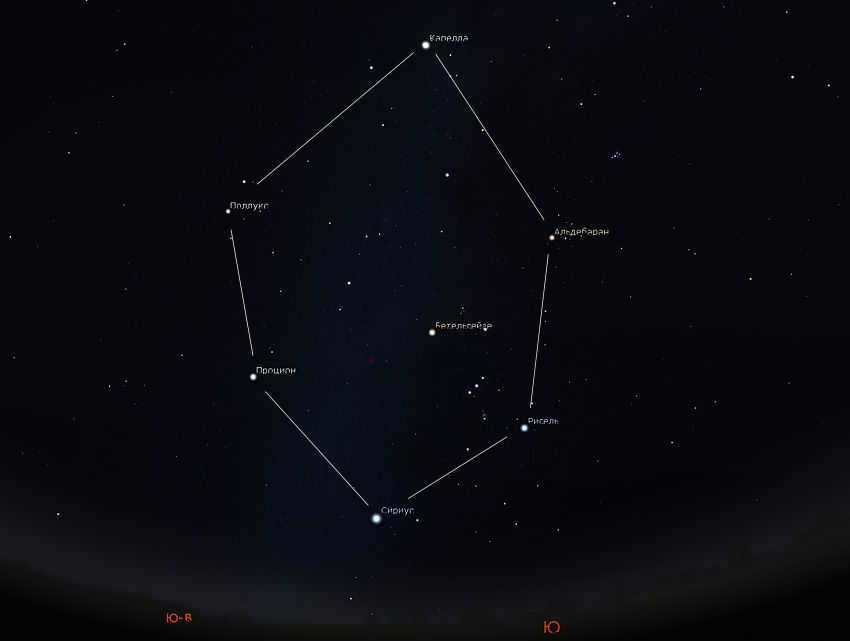
The immense winter hexagon brings together six of the most brilliant stars in the wintertime sky. Illustration: Stellarium
To begin with, take note of the luminous star positioned high above your head. This is Capella, the alpha star of the Ascendant constellation. It serves as the apex of the Winter Hexagon. To the right and below Capella, you will discover Aldebaran, the reddish star that leads the Taurus constellation. Directly beneath Aldebaran lies Rigel, Rigel, the most luminous star in the Orion constellation. Rigel sits relatively low above the horizon, which often causes it to shimmer and display various colors.
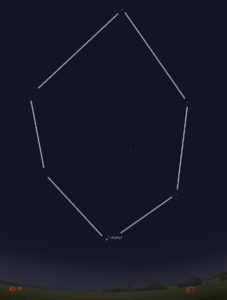
This is how the Winter Hexagon will appear in the Moscow sky with lanterns lighting it up. Image: Stellarium
Rigel shines to the left and below. Sirius is the brightest star in the night sky of Earth. In the evenings, Sirius is positioned very low above the horizon, causing it to frequently twinkle and shimmer in various colors in the middle latitudes – much more intensely than Rigel!
The other two stars of the Winter Hexagon, Procyon and Pollux, are located to the left and above Sirius.
If you try to take in the entire formation at once, you will see something resembling a massive crystal, extending from the zenith to the horizon.
All of the stars in the Winter Hexagon are part of different constellations, making it an asterism rather than a specific constellation.
Betelgeuse in the winter sky
Located at the center of the Winter Hexagon is another prominent star, easily visible due to its reddish hue in the dark rural sky. This star is none other than the renowned Betelgeuse, which serves as the leading star for the constellation Orion.
Betelgeuse has gained widespread recognition due to its immense size, measuring approximately 1000 times larger than the Sun! In terms of stellar evolution, Betelgeuse is considered ancient, nearing the end of its life cycle. It is projected to conclude its existence with a supernova, during which it will shine nearly as brightly as the Moon for approximately six months before ultimately vanishing.
When will this event occur? It could happen in a thousand years or even as soon as tomorrow! In any case, Betelgeuse stands out as the leading candidate for a supernova among stars that are relatively close to our Sun. (By the way, as of 2020, the star’s brightness has significantly decreased. This is not entirely surprising, as Betelgeuse is known to be a variable luminosity star. However, what is remarkable is the extent of its fading – up to 1.5 magnitudes!)
When strolling through the streets of major cities, you will likely only be able to spot the stars of the Winter Hexagon and Betelgeuse in the night sky. However, if you venture outside of the city – whether it be to the countryside, a village, the steppe, or even a large park – you will be greeted by a much grander display of stars. With the naked eye, you can attempt to locate the constellations of winter.
The constellations of the winter sky are vivid and full of expression. In rural areas, the winter night sky offers a breathtaking sight. It can be easily and swiftly explored through the stars of the Winter Hexagon or the vibrant constellation of Orion.
The Orion constellation
Orion is the prominent constellation of the winter night sky. This constellation can be seen on winter nights in the southern region of the sky. It represents the mythical hero hunter from ancient Greek legends.
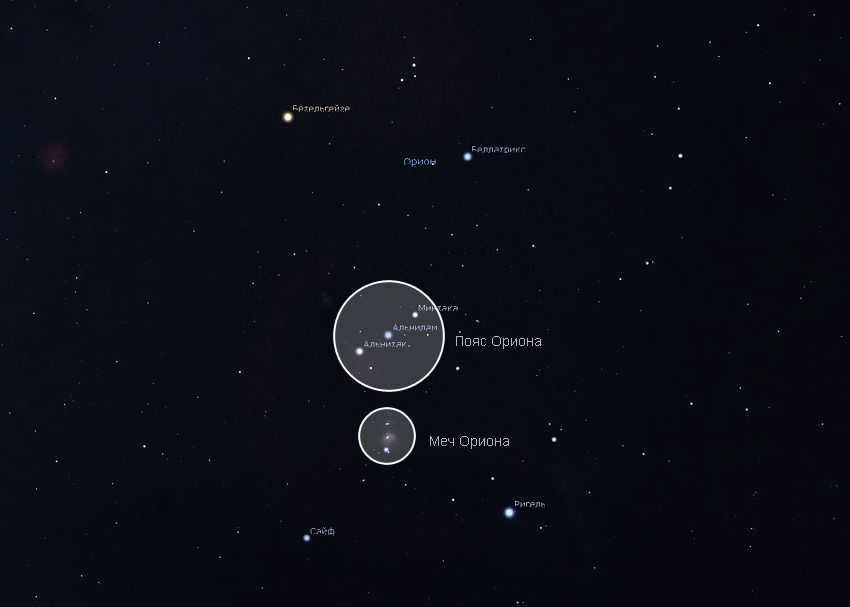

The constellation Orion. Figure: Stellarium
Orion is known for its remarkable symmetry. The arrangement of stars in the constellation is based on three stars of similar brightness, positioned closely together in a straight line. This grouping is commonly referred to as Orion’s Belt.
The two most prominent stars in the constellation, Betelgeuse and Rigel, are positioned symmetrically on opposite sides of the Belt – Betelgeuse to the north and Rigel to the south. Additionally, two other stars, Bellatrix and Saiph, are also symmetrically positioned in relation to the Belt. Together, they form a distinct human figure, with Betelgeuse and Bellatrix representing the hunter’s shoulders and Rigel and Saiph representing the legs.
There is an asterism called The Sword of Orion, which consists of three stars stretching from the Belt downward. It is fascinating to note that in a dark moonless sky, the middle star in the Sword appears slightly hazy and undefined. This particular star is known as the Orion Nebula, which serves as the birthplace for numerous newborn stars and planets.
Don’t you find Orion’s pattern to be incredibly distinctive and instantly memorable? The best part is that its seven brightest stars are so luminous that they can be observed even in a sky illuminated by lanterns or the moon.
The constellations of Taurus and the Great Canine
Orion’s belt acts as a guide to two luminous stars. When the belt line is extended downwards towards the horizon, it directs towards Sirius, the most brilliant star in the nighttime celestial sphere. Conversely, when extended upwards, it passes by the bright star Aldebaran and alongside a small group of faint stars resembling a tiny ladle. In urban areas, this ladle often appears as a blurry mass, resembling a nebulous cloud. This is known as the Pleiades – the renowned diffuse star cluster.
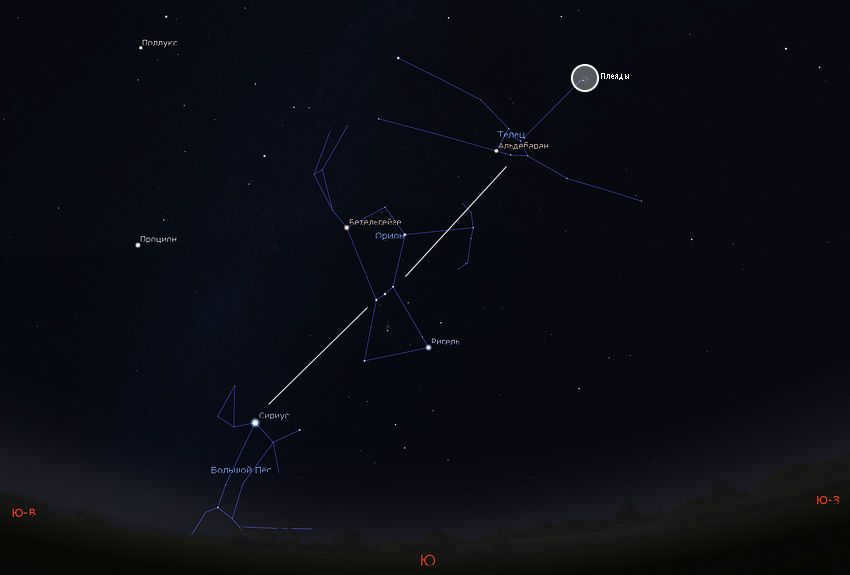

By following the alignment of Orion’s belt, one can easily locate the bright star Sirius and the beautiful Pleiades star cluster. This celestial arrangement can be observed in the night sky. Images from Stellarium showcase this stunning phenomenon.
The zodiacal constellation Taurus includes Aldebaran and the Pleiades. In ancient times, Taurus was depicted as a charging bull, with Orion standing against it, armed with a wand and shield. The prominent star Aldebaran represented the fiery eye of an enraged bull.
Gemini and Ascendant
Situated high above Orion and the entire collection of winter constellations, the brilliant star Capella gracefully hovers in the sky. Capella acts as the pinnacle of the Winter Hexagon. It serves as the focal point of the Ascendant constellation, which takes on the form of an irregular polygon. Interestingly, the Milky Way traverses through Ascendant, making it a captivating subject for observation with binoculars!
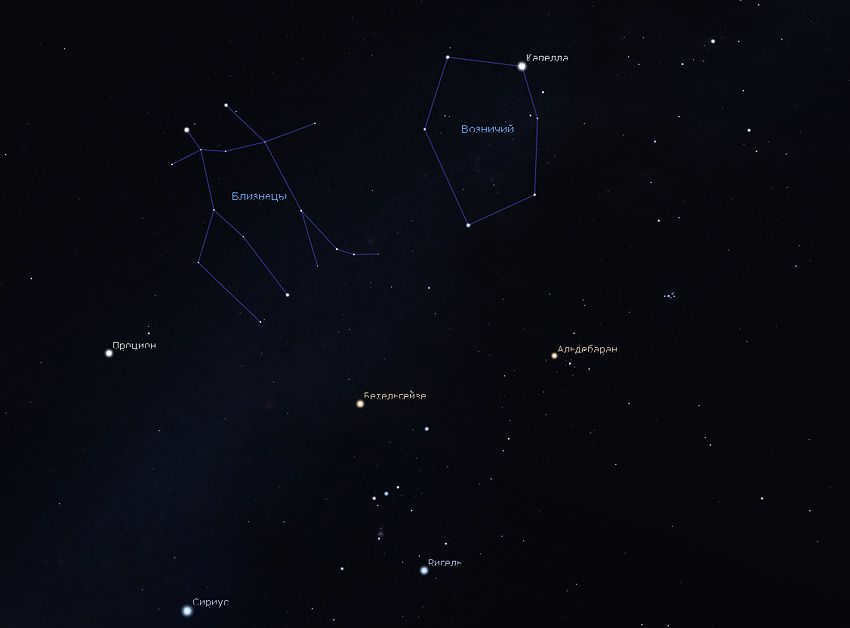
The winter sky is adorned with the constellations of Ascendant and Gemini. This captivating and visually stunning constellation is easily noticeable, with two prominent stars immediately capturing attention. Among the stars in Gemini is Pollux, the lower one, which is included in the Winter Hexagon. Another noteworthy star in this constellation is Castor.
Castor and Pollux, also known as Polydeuces in Greek mythology, are renowned heroes of ancient legends. You’re probably familiar with their tale. They were siblings, but while one was born as a mortal, the other, as the son of Zeus, was gifted with immortality. Tragically, Castor passed away, and unable to bear the loss of his brother, Polydeuces beseeched Zeus for the permission to join him in death. As a result, Zeus granted them both the privilege of spending one day on Earth and another in Tartarus. In recognition of their profound fraternal love, the image of the brothers was immortalized in the night sky as the constellation Gemini.
The depiction of the two brothers, locked in an embrace, can be easily discerned with a quick glance, provided that the sky is truly devoid of light and the moon’s radiance.
Perseus
One of the constellations that can be included in the group of winter constellations is Perseus, which can be seen almost directly above in the early evening sky. This particular constellation is famous for its star clusters and the variable star Algol.
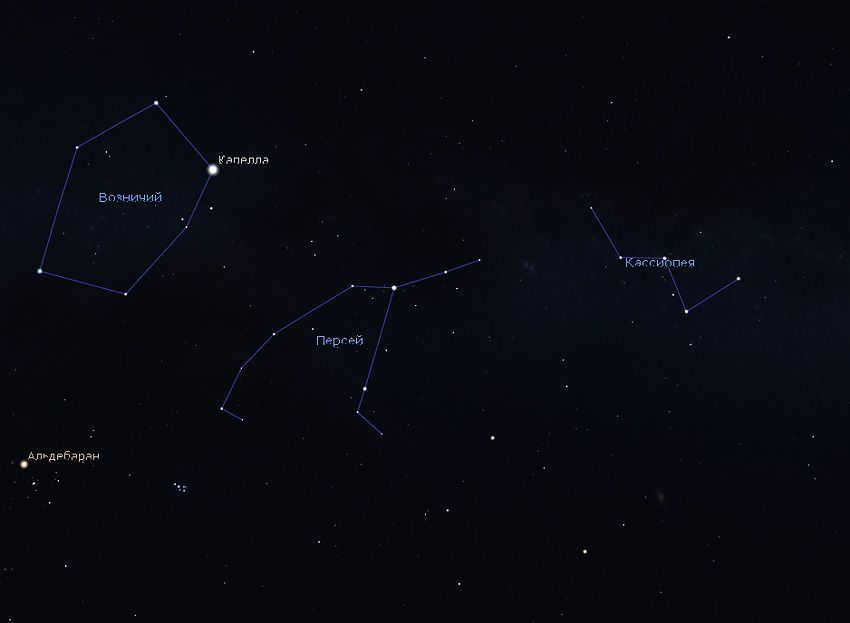
During winter evenings, the constellation Perseus can be observed near its highest point in the sky. To the right of Perseus is the constellation Cassiopeia. Image: Stellarium
Perseus appears similar to an inverted slingshot, with the upper part of the constellation indicating the direction of Cassiopeia. The constellation has a distinct shape resembling the letter “W”. Unlike Perseus and other winter constellations, Cassiopeia is considered a non-sunsetting constellation. It shares the winter sky with other constellations such as the Little Dog.
The rest of the winter constellations are less impressive. They can be located based on the ones already mentioned.
Positioned between Sirius and Pollux is the luminous star Procyon. It, along with another star, creates a compact constellation known as the Little Dog. (Both the Big Dog and the Little Dog are companions of the hunter Orion.)
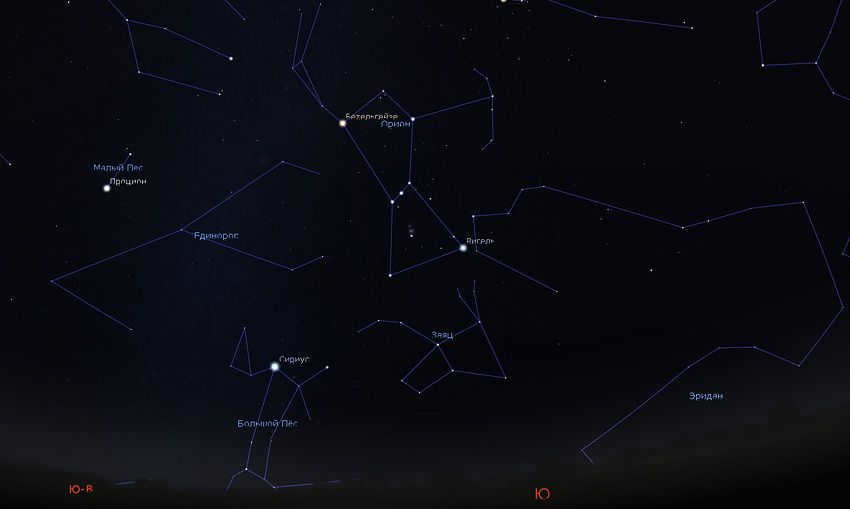
The constellations of the Little Dog, Unicorn, Hare, and Eridanus can be located by starting from the constellation Orion. Image: Stellarium
The area of the night sky between Procyon and Sirius, to the left of Orion, is inhabited by the constellation known as the Unicorn. The Unicorn constellation is situated in a dark region of the sky where the Milky Way passes through, making it a rich area for star clusters and nebulae. To observe these celestial objects, a telescope and a location with minimal light pollution are necessary.
Just under the constellation of Orion lies a compact constellation known as Hare. An assemblage of dim stars to the right of Orion shapes the constellation of Eridanus. In the Russian skies, Eridanus can only be seen partially. This extensive constellation, representing a legendary river, stretches far to the southern region and culminates with a brilliant star called Ahernar.
Winter Starry Sky in Various Russian Cities
We have acquainted ourselves with the general features of the dazzling stars and constellations that adorn the winter sky. One might wonder: which cities can benefit from this overview?
The answer is quite simple: virtually any city, region, or republic in Russia, as well as neighboring countries. The winter sky in Siberia is nearly identical to that of Crimea, St. Petersburg, Moscow, Almaty, Kiev, and Minsk. The only distinction lies in the latitude of the observing location. In the northern areas, the Hare constellation remains unseen, while Sirius is the only star visible in the Canis Major constellation. Conversely, being in southern Russia allows for a glimpse “beyond the horizon” of northerners, revealing the constellations of Korma, Compass, and Dove.
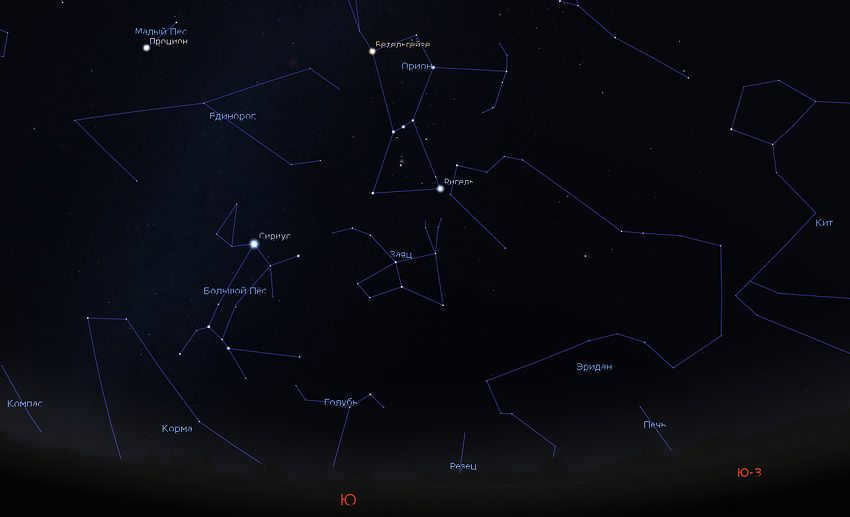
The image presented here displays the sky over the Caucasus region, contrasting with the earlier figures that showcased the sky over central Russia. This particular image reveals several constellations located to the south of Orion, which are not observable from Moscow. These constellations include Razetsets, Compass, Furnace, and Dove. The image has been sourced from Stellarium.
Does the appearance of the starry sky alter over time?
No, it does not! The relative positioning of the stars in the sky has remained unchanged for millennia! If you happen to notice a radiant star in the winter sky, there is a possibility that it is a planet!
Planets traverse the zodiacal constellations along the ecliptic. Consequently, you will only encounter them in the winter sky within the constellations of Taurus or Gemini. (In 2020, Venus, the most brilliant planet in our sky, will traverse through these constellations during the spring season!)
Depending on the time of year, the appearance of the night sky filled with stars varies. The constellations that were once visible during winter nights become obscured during the summer months due to their alignment with the Sun. This cosmic phenomenon occurs as a result of the Earth’s orbit around the Sun, which causes its nocturnal hemisphere to gradually shift away from certain constellations.
During the winter months, the nights in Russia and the surrounding countries are characterized by their length. Interestingly, in addition to the typical winter constellations, one can also observe constellations that are associated with autumn, spring, and even partially summer. On the other hand, the nights in summer are quite short, especially in the northern regions of Russia, where they are also remarkably bright and luminous. Despite the limited duration of star visibility in the sky during these short summer nights, the Earth’s rotation on its axis does not allow for significant changes in the starry sky. This phenomenon is in stark contrast to the winter season. However, towards the end of August, the movement of the starry sky becomes more noticeable. During this time, in addition to the summer constellations, it is possible to observe constellations that are typically associated with fall, and even a few that are typically associated with winter.
Since the nights are shorter in the summer, it presents a great opportunity to observe the beautiful starry sky. One can begin by focusing on the most luminous stars that appear during the evening twilight, and then proceed to study the various constellations. In St. Petersburg, during the first half of the summer, the sky remains quite bright even at night, making it easier to spot only the brightest stars.
What exactly does the summer starry sky hold in store for us?
Summer Sky Constellations
Only a portion of all constellations can be seen from Russia, as the rest are located so far south that they never rise above the horizon. Metaphorically speaking, they are always beneath our feet. The visible constellations can be divided into two main categories: seasonal and circumpolar.
Circumpolar constellations remain above the horizon throughout the year, and are therefore visible in the sky at all times. Examples of these include the Big Dipper, Cassiopeia, and the Little Dipper. Seasonal constellations, on the other hand, vary depending on the time of year and can be further divided into summer, fall, winter, and spring constellations.
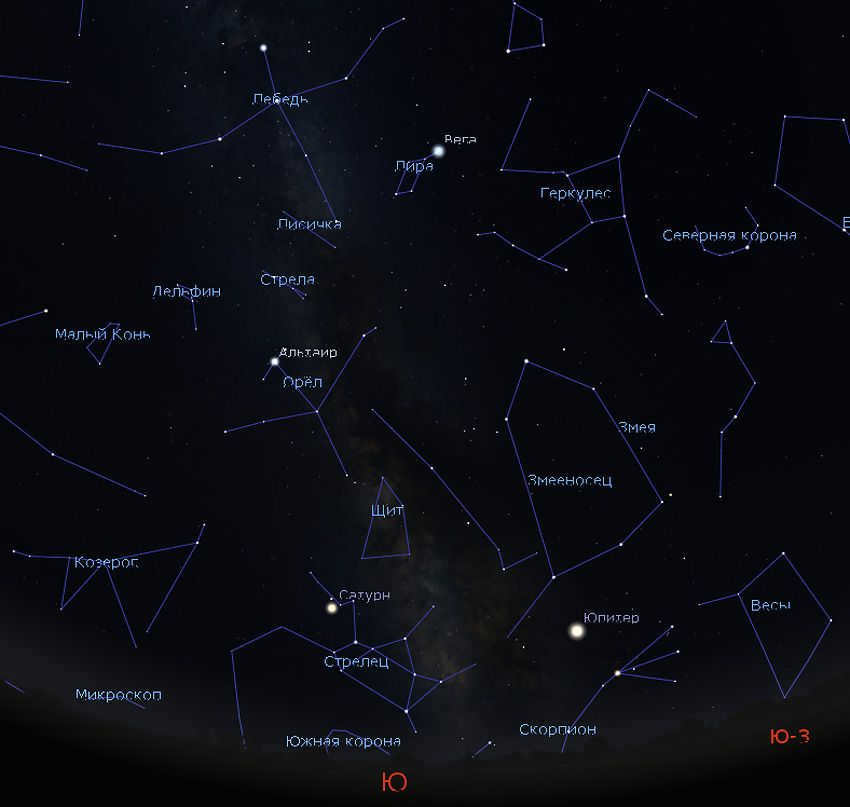
A general representation of summer constellations can be observed in the latitudes of Volgograd, Rostov-on-Don, and Odessa. The illustration is provided by Stellarium.
The constellations commonly associated with summer include Northern Crown and Hercules, Serpent and Serpent, Scorpio and Lyra, Swan and Eagle, The arrow and Chanterelle, The Shield and Dolphin, Capricorn and Sagittarius. Additionally, Aquarius and Lizard are sometimes considered as summer constellations. In southern Russia, the constellations of Southern Crown and Microscope are also visible.
How can I locate these constellations in the night sky?
To locate these constellations, follow this general rule: on summer nights, they can all be found in the southern part of the sky, stretching from southwest to southeast.
You may wonder: when exactly in the evening? The answer is: just after sunset. It’s important to note that the time of twilight varies depending on your location. For example, in Sochi, twilight comes much earlier in the summer compared to St. Petersburg, where it is almost daylight all night long. Nevertheless, the general rule still applies. If in your city the stars become visible around midnight in June, we can consider that as evening.
Let’s imagine it’s the middle of summer, the evening has arrived, and the stars have made their appearance in the sky. Positioned high above in the southern part of the sky, you will notice a significant triangular formation composed of three brilliant stars, with the apex pointing towards the horizon. These stars are known as Vega, Deneb, and Altair, and the shape they create is referred to as the Summer Triangle (also known as the Summer-Autumn Triangle or the Great Summer Triangle). It is not classified as a constellation, but rather as an asterism since it includes stars from three distinct constellations.
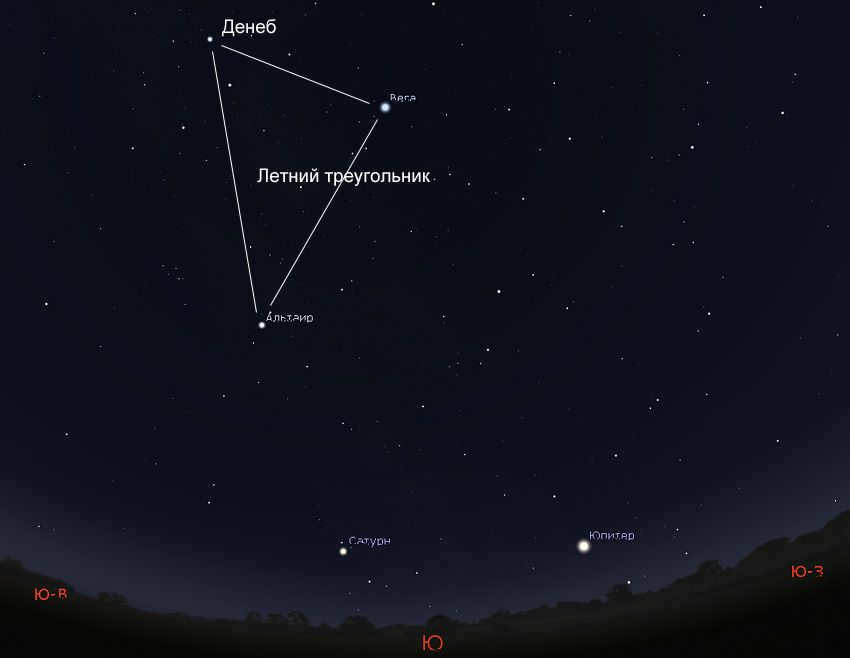
During the summer nights, the Summer Triangle can be seen high above the southeastern horizon, and in the month of August, it can be observed above the southern horizon. This celestial pattern, as shown in the image, is known as the Summer Triangle and serves as a guide to locate other constellations that are visible during this season.
The constellations of Lyra and the Swan
The most prominent star of the triangular formation, known as Vega and situated in the upper right corner, is a part of the small constellation Lyra. Lyra’s main configuration is a small parallelogram positioned directly below Vega, consisting of stars with magnitudes of 3-4. There are several other faint Lyra stars scattered around Vega and this parallelogram.
The star Deneb, which forms the upper left corner of the Summer Triangle, also happens to be the brightest star in the Swan constellation. The Swan is widely regarded as one of the most exquisite and visually striking constellations in the entire night sky. It is composed of five stars, including Deneb, that form a large cross shape. This particular pattern is commonly referred to as the Northern Cross.
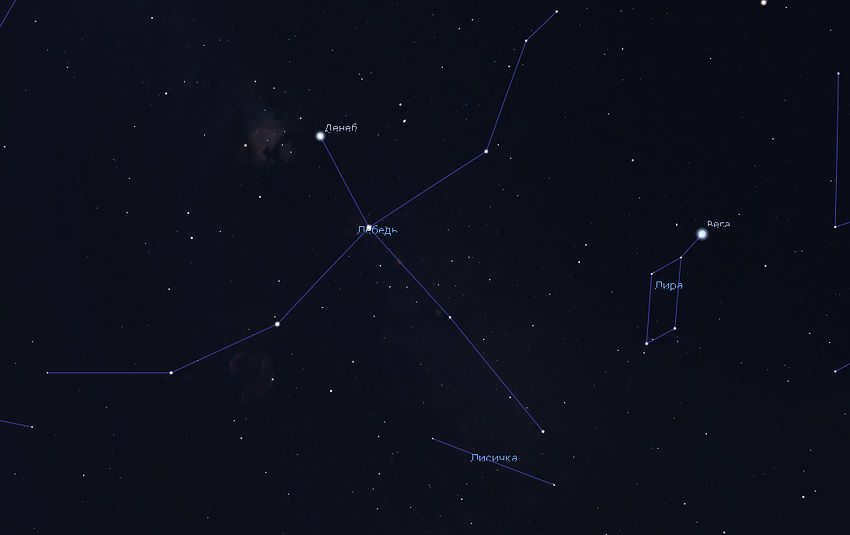
The constellations Lyra and the Swan. Deneb indicates the tail of the Swan, while the star Albireo designates the head of the bird. On exceptionally clear and dark evenings, it is possible to observe a nebula known as North America (pictured to the left of the star) in close proximity to Deneb. Source: Stellarium
The constellation Eagle and its accompanying celestial bodies
Star Altair, positioned at the apex of the Summer Triangle, serves as the focal point of the constellation Eagle. Two other relatively bright stars are situated near Altair, one above and one below. These three stars collectively form the tail of the Eagle, while the body, head, and wings, composed of fainter stars, can be found to the right and below Altair. The figure of the Eagle can only be clearly observed in the pitch-black countryside sky. The bird is depicted in flight, facing the same direction as the Swan.
Between Altair and Albireo, which is the head of the Swan, lie two small constellations known as the Arrow and the Fox. The Arrow, resembling an arrow shape, cannot be seen with the naked eye. The stars of the Fox constellation can only be seen outside of urban areas.
To the left of the Arrow and Altair, next to the Summer Triangle from the east, is the elegant constellation of Delphinus. The animal’s body is represented by a tiny rhombus of 4th magnitude stars, while the tail is symbolized by the two stars below and to the right.
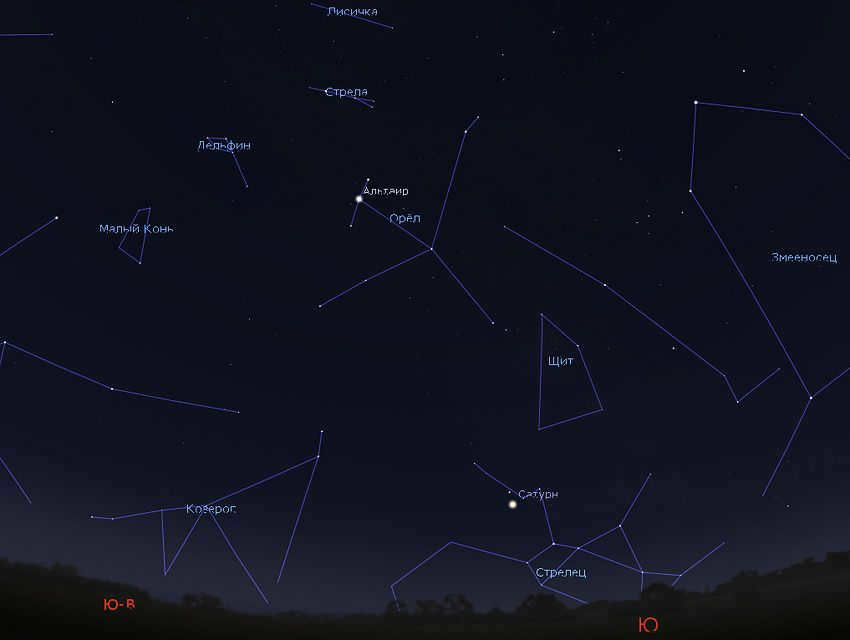
This diagram illustrates the appearance of several constellations in the summer night sky at the latitudes of Moscow, Minsk, or St. Petersburg. Specifically, it showcases the constellations of Eagle, Dolphin, Arrow, and Fox, along with Shield and Sagittarius. This information has been sourced from Stellarium.
Constellations of the summer sky in the Southern Hemisphere
Hovering just above the horizon are the zodiacal constellations of Sagittarius, Capricorn, and Aquarius. Aquarius (specifically its western part) and Capricorn are positioned beneath the constellation of the Dolphin, while Sagittarius is situated beneath the constellation of the Eagle. Sagittarius, being the southernmost constellation of the Zodiac, can only be fully seen in the southernmost regions of Russia, and at the latitudes of Moscow or St. Petersburg, it is only partially visible.
Between Sagittarius and the Eagle lies the inconspicuous constellation Shield. Although the naked eye can only perceive a few faint stars, the use of binoculars or telescopes reveals a multitude of stars in this area!
Let’s go back to the constellation Lyra and the star Vega, which we started describing the summer constellations, and turn our attention to the west.
Hercules and the Northern Crown constellations.
The vast expanse to the right of Lyra is occupied by the Hercules constellation. Hercules.. In the urban sky, you may only see a dozen or two faint stars in this area, but outside the city, you will see a hundred more! These stars can easily form a humanoid figure, as the ancient Greeks believed.
To the right of Hercules, there is a small semicircle of dim stars. This is the Northern Crown constellation.. The brightest star in the Northern Crown, Gemma, is located in the center of this ring, shining like a precious gem.
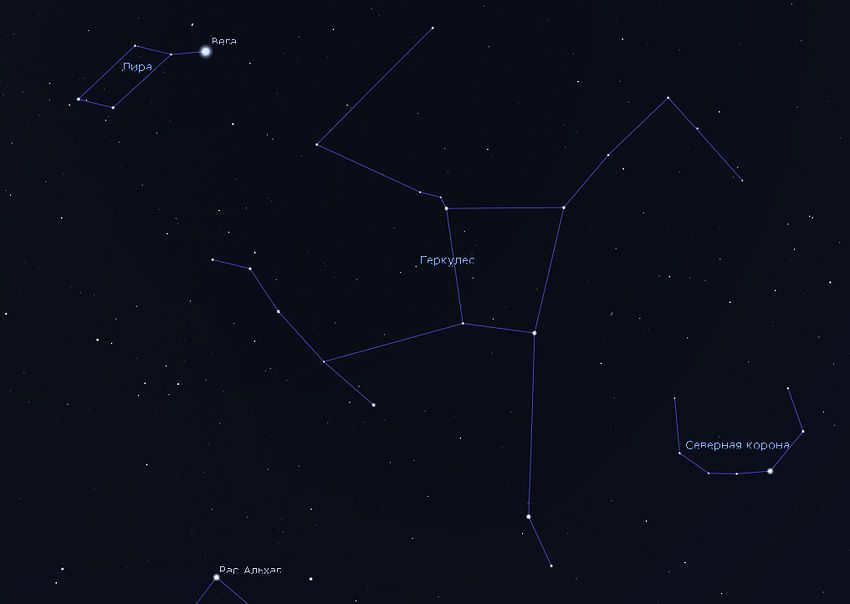
Hercules and the Northern Crown can be seen to the west of the Summer Triangle and the constellation Lyra. Image: Stellarium
Serpent, Snake, and Scorpio
What lies beneath the Hercules constellation and to the right of the Eagle constellation?
That’s where you can find the Serpentarium, whose brightest stars form a large irregular pentagon, resembling a crystal. The Serpentarium is similar in size to the Swan constellation and occupies nearly the same area as Hercules. The southern part of the Serpentarium is close to the horizon, allowing the paths of the Sun, the Moon, and planets to pass through it.
The Snake constellation is the final summer constellation. What makes it unique is the fact that it is the only constellation in the sky that is divided into two parts. The tail of the Serpent is positioned between the constellations of the Shield and the Eagle on one side, and the Serpentine on the other. The head of the Serpent can be found to the right of the Serpent constellation, just below the Northern Crown constellation. In ancient times, the Serpent was seen as a representation of Aesculapus, the god of medicine, who carried a snake with healing venom. Even today, many medical institutions use a coiled snake on a bowl as their symbol.
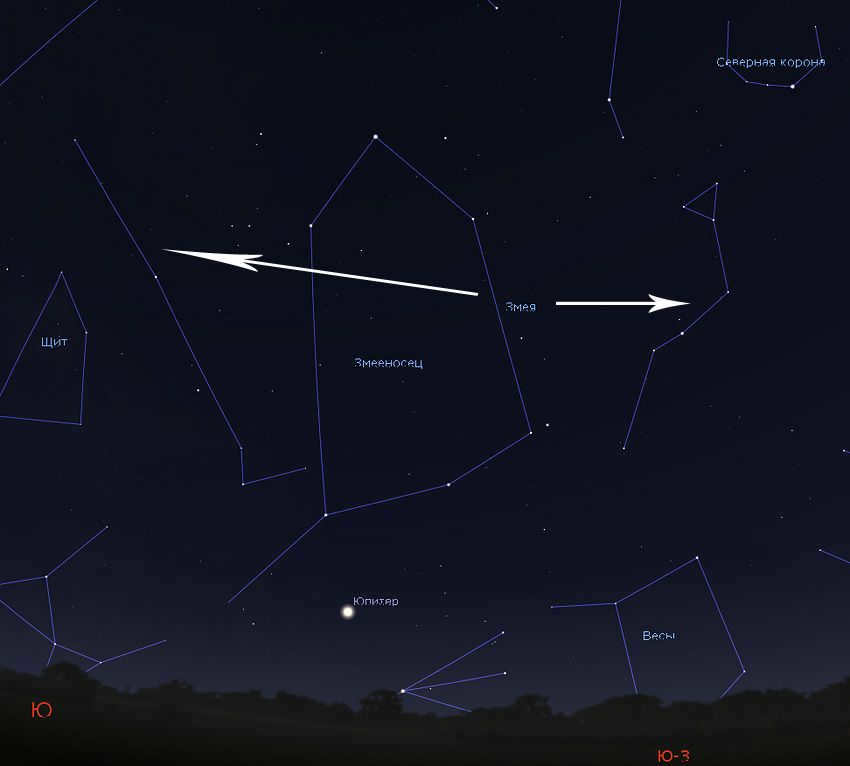
Below the constellation Hercules, you can find the Serpentine and two chains of stars that make up the constellation Serpentus. Continuing downwards, you can see the stars of Scorpio, led by Antares, as they set over the horizon. This image is provided by Stellarium.
Take note: Descending across the Summer Triangle and towards the horizon is the Milky Way. The Milky Way track is particularly bright in the constellation Sagittarius, which is where the center of the Galaxy is located. However, Sagittarius is only clearly visible in southern Russia, while in temperate latitudes, the brightest areas of the Milky Way can be found in the constellations of Swan, Arrow, Eagle, and Shield.
Make sure to observe the Milky Way using binoculars or a small telescope. You will witness vast fields of stars in every direction!
Astrophysical Objects in the Summer Season
Now, let me provide some information about the most prominent stars that can be seen in the summer sky.
The constellations that dominate the summer sky consist of four stars with a magnitude of one or greater. I have already mentioned all of them, but I will list them once more. These stars are Vega, Deneb, and Altair, which form the Summer Triangle, as well as the star Antares from the Scorpius constellation. While the first three stars are visible throughout Russia, Antares can be clearly seen only to the south of Moscow. As one moves further north, like in St. Petersburg, it becomes increasingly challenging to observe Antares due to its low position in the sky and the presence of white nights.
The fourth star can be found in the western sky during summer evenings, situated to the right of the Northern Crown constellation. This star is known as Arcturus, and it is renowned for being the brightest star in the northern celestial hemisphere.
Lastly, if you look towards the north and gaze low above the horizon, you will find the star Capella. It belongs to the Ascendant constellation and is considered the queen of winter nights. (Interestingly, in the southern part of Russia, Capella actually sets below the horizon during the summer!)
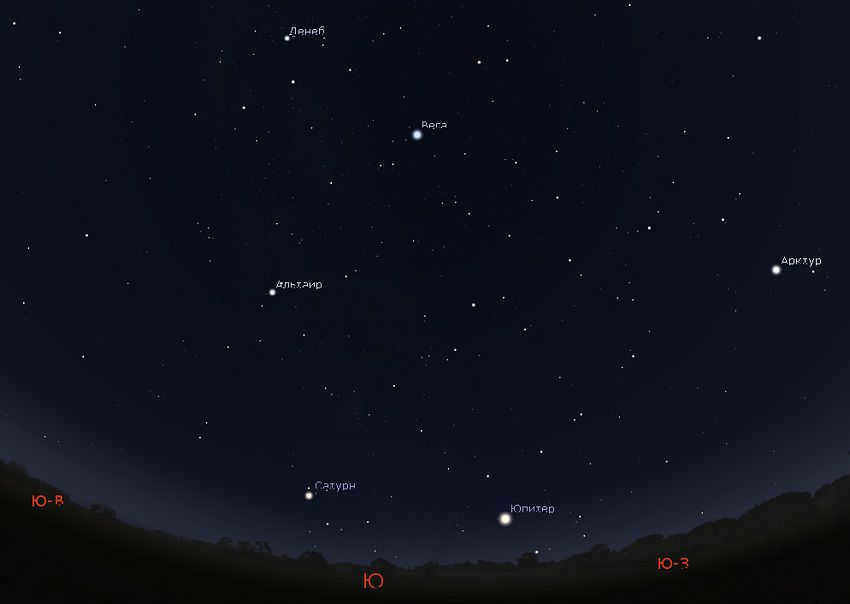
Witness the brilliance of the most vibrant stars and planets in the summer sky. The image represents the celestial arrangement for July 2019. In the forthcoming years, the arrangement of constellations will remain the same, but the planets will alter their positions! Image: Stellarium
Lastly, kindly allocate a bit more attention! During the summer season, it is not uncommon to spot peculiar stars hovering low above the horizon within the constellations of Scorpio, Serpentor, Sagittarius, or Capricorn. These celestial bodies usually outshine the rest of the stars and, in contrast to them, seldom flicker. By now, you have probably deduced that these are indeed the planets. planets.
Novice astronomy enthusiasts often find it difficult to distinguish between planets, especially bright ones like Jupiter, Venus, Saturn, and even Mars. These planets have a tendency to attract attention and disrupt the usual patterns of constellations. For instance, during the summer of 2019, two bright planets, Jupiter in Serpentor and Saturn in Sagittarius, were visible simultaneously. Jupiter is typically the fourth brightest celestial object in the sky, following the Sun, Moon, and Venus, making it easily visible even during early twilight. Saturn, on the other hand, has a brightness similar to that of Vega or Altair.
The planets in the summer sky are always (always!) positioned low on the horizon as they traverse through the southern zodiacal constellations. So where can one observe the planets at a higher altitude during this time of year? The answer lies in the southern hemisphere of the Earth, specifically in locations like Argentina or Australia!
Instead of just learning about the summer starry sky theoretically, I suggest going outside to the yard, the seashore, the field, or the steppe and actually experiencing it firsthand!
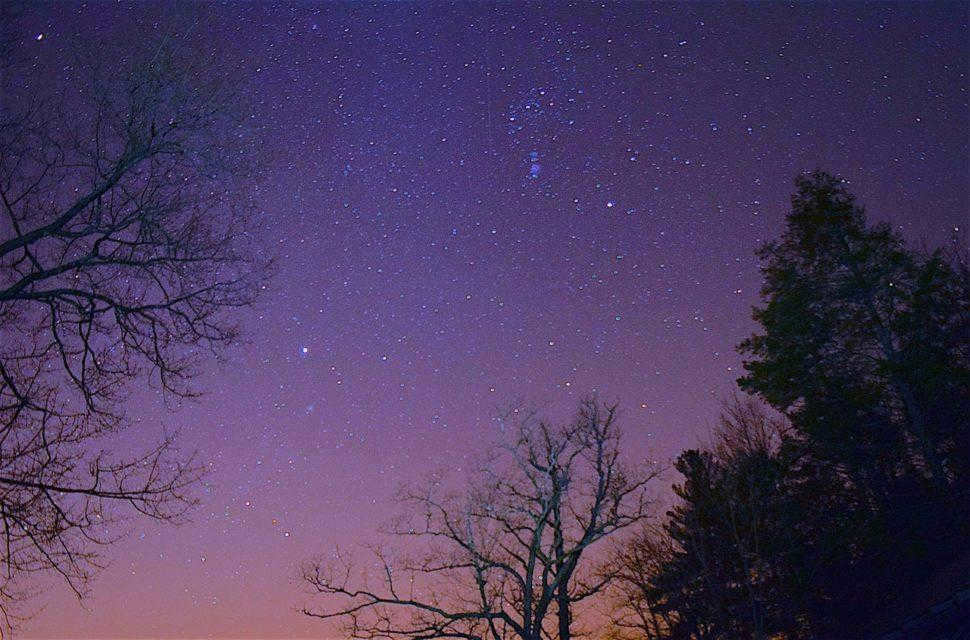
As spring arrives, not only does nature undergo changes, but so does the celestial scenery. During the month of March, new constellations become visible in the southern part of the sky, while in the east, constellations that are just beginning to rise can be seen, although they won’t be fully visible until April. At the same time, the winter constellations gradually shift to the west and will eventually disappear completely by April. Meanwhile, the northern part of the sky is home to constellations that never set.
Constellations Visible in the Spring Sky
Below is a table containing the names of the constellations that can be observed in the night sky during the spring months. The list is divided into constellations visible in the Northern Hemisphere, Southern Hemisphere, and the Equatorial region.
The constellations are labeled as follows: C – Northern Hemisphere; S – Southern Hemisphere; E – Equatorial region
| Cancer (C) | Pump (S) | Hound Dog (C) |
| Small Dog (C) | Chameleon (Y) | Centaurus (Y) |
| Keel (Y) | Bowl (Y) | Veronica’s Hair (C) |
| Lynx (C) | Hydra (Y) | Raven (Y) |
| Feed (Y) | Lion (C) | Southern Cross (Y) |
| Compass (Y) | Small Lion (C) | Fly (Y) |
| Sails (Y) | Sextant (E) | Virgo (E) |
| Flying Fish (Y) | Big Dipper (C) |
In the evening hours of March, you can observe the winter constellations in the southwestern part of the sky. These constellations are gradually moving away, making space for the spring constellations.
Heading towards the North
Not too far from the zenith, you can spot the prominent Big Dipper constellation. The following stars of the “Bucket” are especially visible: Merak, Dubhe, Megretz, Fekda, Mitsar, Aliot, Benetnash. Some may also see Alcor, a solitary star near Mitzar. Spotting Alcor has become a traditional method of testing vision. These paired stars are also incredibly clear when observed through a telescope.
The Serpentine constellation ascends in the eastern region of the celestial sphere, slightly further away can be found the star conjunction of Hercules, and even more distant is the Dragon’s Head. In contrast, Lyra emerges in the northeast. On the horizon lies the Swan. Towards the north is Cassiopeia, to the upper right is Cepheus, and to the upper left and northwest is Perseus. Orion traverses the western sky, and just above it are the constellations of Ascendant and Gemini.
Heading towards the South
In the vicinity of the prominent asterism known as the Big Dipper, lies the constellation Leo, which boasts the presence of the brilliant star named Regulus. On the southeastern side of the celestial sphere, one can easily spot Volopassus, while in the eastern direction, the Northern Crown can be observed.
The Star at the Center
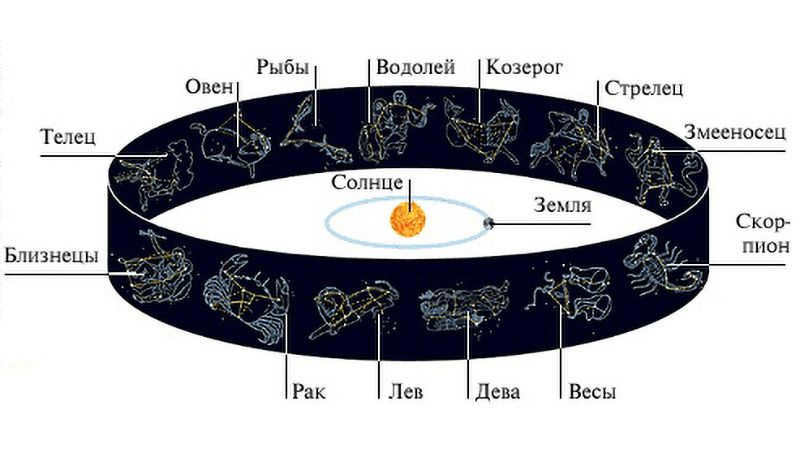
As we move through the month of March, the Sun is transitioning from the zodiacal constellation Aquarius to Pisces. Its journey brings it closer and closer to the celestial equator, and on March 20th, it will finally reach its destination. This celestial event marks the arrival of astronomical spring in the northern hemisphere, known as the vernal equinox, while in the southern hemisphere, it signals the onset of autumn, also known as the autumnal equinox.
During this transitional period, the length of daylight increases while the duration of the night decreases. In Moscow, the latitude where I am based, the daylight hours grow from 10 hours and 43 minutes to 13 hours and 2 minutes. Additionally, the Sun’s maximum height above the horizon changes from 26 degrees to 38 degrees throughout the month of March.
Major Bear
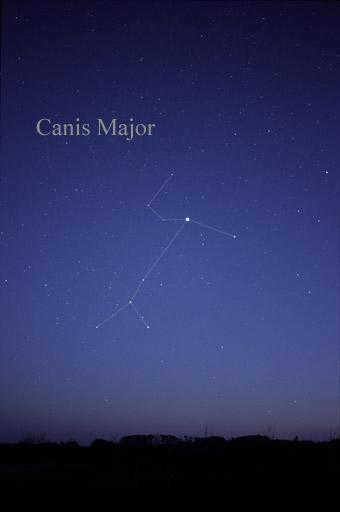
The Big Dipper reaches its highest point in the sky, known as its zenith. This constellation can be seen throughout the year, but March offers the most favorable conditions for observing it.
During this time, it becomes easier to notice that the second star on the handle of the dipper is actually a double system. This system consists of the stars Mizar and Alcor, with the latter being much smaller. The ability to distinguish between these two stars has been considered a test of visual acuity since ancient times.
Dubhe and Merach form the outermost “wall” of the dipper, and they are among the brightest stars in the constellation. However, the brightest star on the handle of the dipper is Aliot.
The Big Dipper is the third largest constellation out of all the known constellations. It is home to one of the largest spiral galaxies, which has a supermassive black hole at its center.
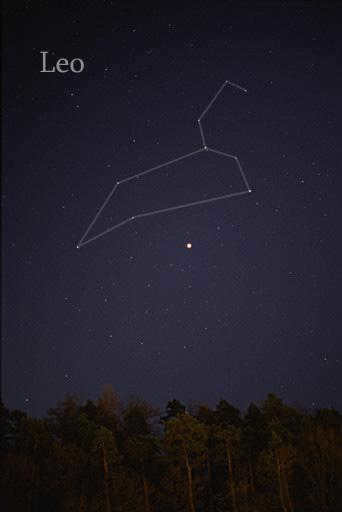
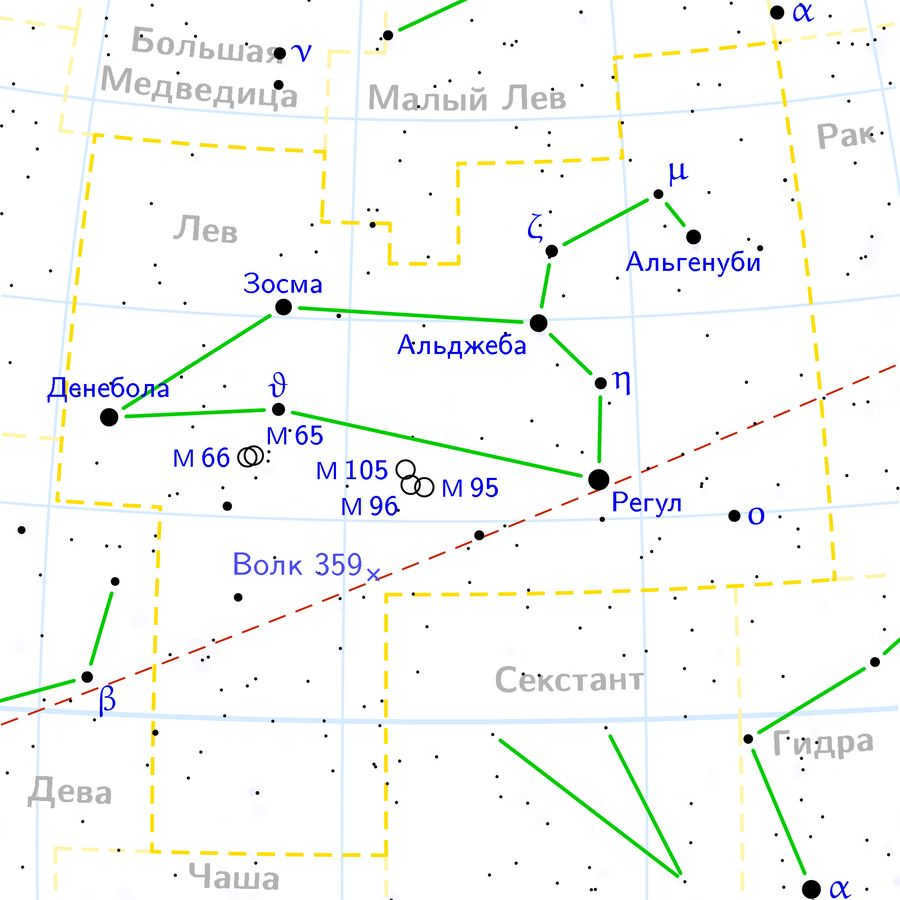
If you trace a line heading south from the farthest point of the Big Dipper’s “bucket wall,” you will arrive at the Leo constellation. This cluster of stars is quite expansive and boasts around 70 stars that can be seen with the naked eye, making it relatively easy to locate. Among the brightest stars are the blue-white Regulus, representing the “heart,” and the radiant white Deneloba, which forms the “tail tassel.” Another standout star is Algieba, positioned at the base of Leo’s “head.”
Within the constellation lies the Leo Triplet, a grouping of three spiral galaxies that appear close together. This proximity is what earns them their collective name. Additionally, the Lion Ring resides within Leo—a massive cloud composed of hydrogen and helium that developed along the boundary of two dwarf galaxies’ orbits.
There exist celestial bodies within the constellation. Within this constellation, one can identify vast clusters of quasars, with one particular cluster known as Huge-LOG being the second largest of its kind in the universe.
The Crab
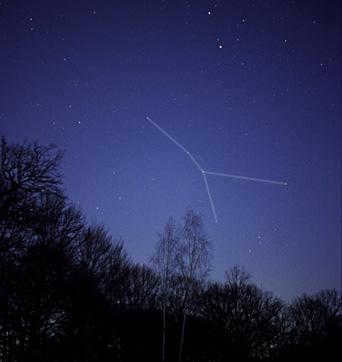
Located to the East of Leo is the Cancer constellation. This constellation is not very bright, making clear weather and an area without city lights the best conditions for observation. The brightest star in the constellation is Altarf, also known as Beta Cancer. It can be found in the lower right part of the constellation, which has a shape resembling an inverted letter Y.
In the center of the Cancer constellation is a scattered star cluster called the Crèche, sometimes referred to as the Beehive. It appears as a hazy spot to the west of a line connecting two stars known as the Donkeys. This star cluster is one of the closest to Earth, making it ideal for observation.
Another star cluster, M67, is located near the star Acubens, also known as Alpha Cancer. It can be found to the left of the lower two stars in the constellation. The M67 star cluster is one of the oldest in the universe, estimated to be around 4 billion years old.
Volopassus
can be rephrased as
Volopassus is an online platform
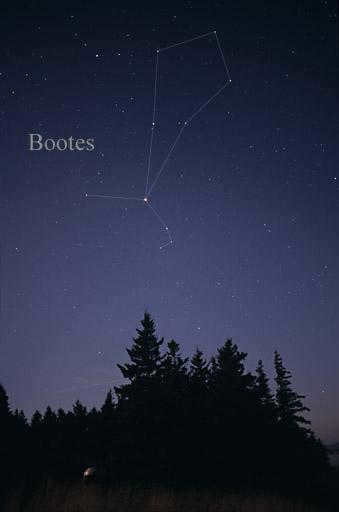
Volopassus is located to the southeast of Leo. The constellation has the shape of a paper kite or a parachute tilted sideways.
The brightest star in the constellation and the second brightest star in the entire sky is Arcturus, an orange giant. Arcturus is an aging and cooling star that has a mass nearly equal to that of the Sun but shines 133 times brighter. It can be easily seen even in hazy urban environments.
The constellation is home to one of the most desolate regions in the universe, known as the Volopassus Void. This area of space contains a very small number of galaxies – only 60, whereas according to the constellation’s characteristics, there should be around 2000.
Additionally, the Cloverleaf quasar is also found in this constellation. It is a source of X-ray radiation surrounding a supermassive black hole.
Virgo
The sixth astrological sign in the zodiac, Virgo, is often associated with traits such as attention to detail, practicality, and a strong sense of responsibility. This sign is ruled by Mercury and is symbolized by the virgin. Those born under the sign of Virgo are known for their analytical nature and ability to analyze situations thoroughly before making decisions.
Virgos are often seen as perfectionists, as they have a keen eye for detail and strive for excellence in everything they do. They are highly organized individuals who enjoy creating order and structure in their lives. Their practical nature makes them excellent problem solvers, and they are often sought after for their advice and guidance.
While Virgos may appear reserved and cautious at first, they are incredibly loyal and devoted friends once they open up. They value honesty and integrity and expect the same from those around them. Virgos are also known for their humility and modesty, often downplaying their own accomplishments and putting others’ needs before their own.
In relationships, Virgos are thoughtful and caring partners who seek stability and security. They are not ones to rush into love but instead take their time to ensure compatibility and trust. Once committed, Virgos are loyal and dedicated to their partners, always striving to make them happy.
Overall, Virgos possess a unique blend of intelligence, practicality, and attention to detail that sets them apart from other signs. They are often seen as reliable and hardworking individuals who excel in their chosen fields. While they may be perfectionists at times, their analytical nature and problem-solving skills make them valuable assets in any situation.
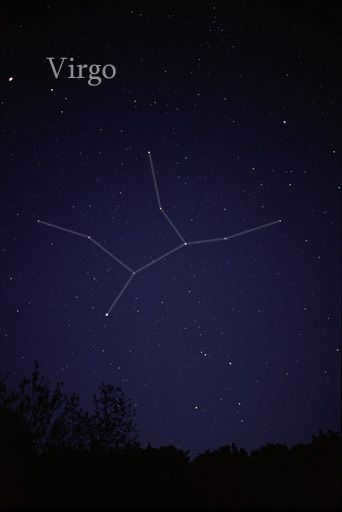
To the south, positioned between Tiberius and Leo, lies the constellation Virgo, which ranks as the second largest constellation in the night sky. During the month of March, Virgo is easily observable throughout the entirety of the night. Notably, Virgo currently encompasses the location of the autumnal equinox, which marks the moment when the Sun crosses the celestial equator in its visible trajectory across the sky.
The most prominent star within Virgo is Spica, which is situated at the bottom of the constellation. To locate Spica, one must draw an arc connecting the first three stars of the Big Dipper’s handle, extending through Arcturus and Volopas. Continuing along this line will intersect with Spica in Virgo. Spica, along with Arcturus and Volopas in Leo, form the brilliant Spring Triangle.
Clusters of galaxies can be found in the region of the constellation that is closest to Leo. One notable cluster is M87, also known as the Virgo Cluster. In 2019, astronomers captured an image of a supermassive black hole at the center of this cluster, which gained significant attention. This black hole is surrounded by a jet of high-velocity plasma that emits various forms of radiation.
March is a month when meteor streams known as Virginidae can be observed. The Alpha Virginids are particularly active during this time, with their peak activity lasting from March 10 to May 6. Another meteor stream, the Pi-Virginids, has its peak activity between March 3 and 9.
Hydra
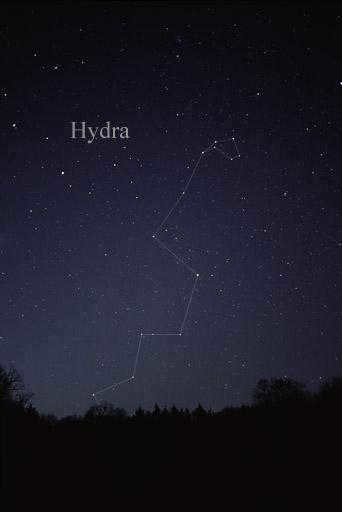
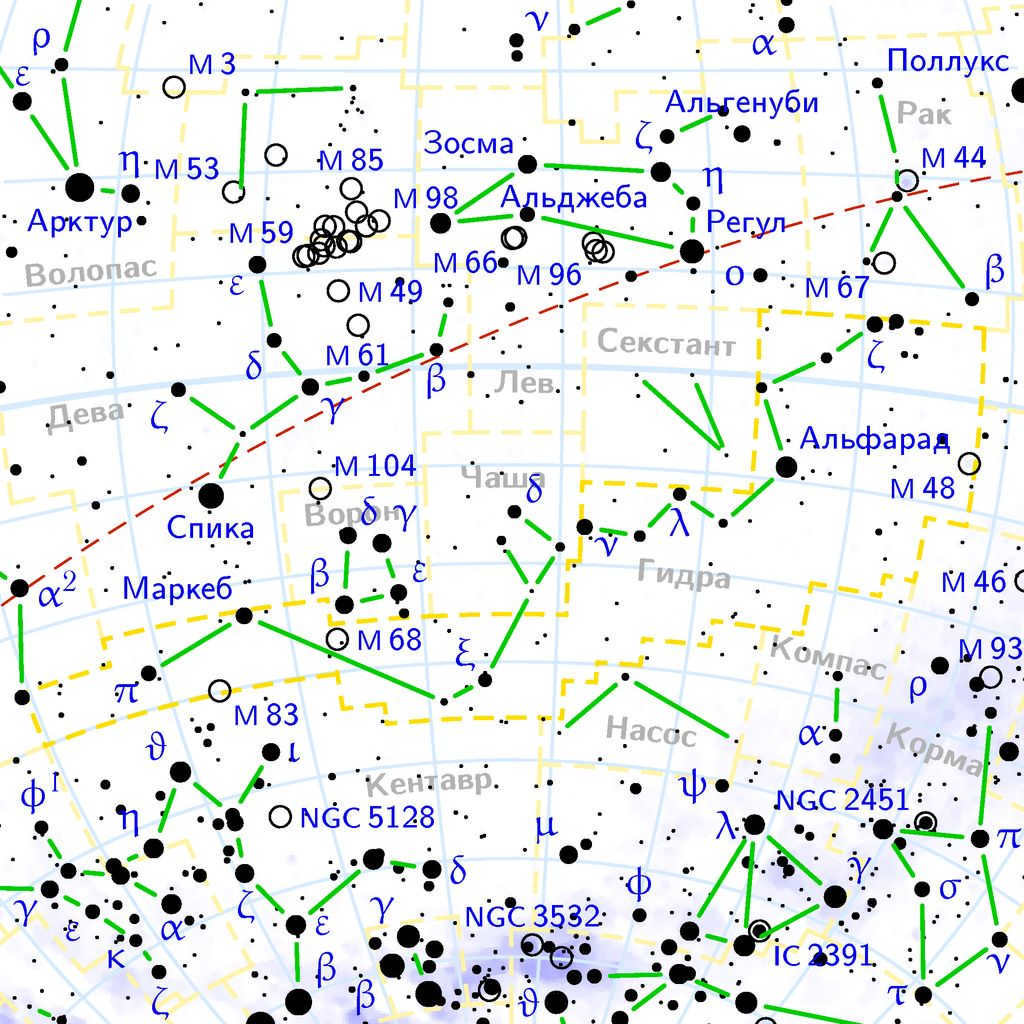
Located below Virgo and Leo, closer to the horizon, lies the expansive constellation known as Hydra. Standing out as the brightest star within Hydra is the magnificent orange giant known as Alfard. Translated from Arabic, its name means “lonely,” as there are no other prominent stars in its vicinity.
Hydra boasts a total of 14 brilliant stars. They form a lengthy, curving line that stretches from east to west, culminating in a cluster of stars that form the shape of an irregular pentagon – commonly referred to as the “Head of Hydra.” These members of the group emit a faint yet noticeable brightness.
Near one of these stars, Gamma Hydra, the naked eye can catch a glimpse of the red giant known as R. Interestingly, this star undergoes periodic changes in its luminosity over long periods of time.
Hydra is also home to several hundred galaxies and planetary nebulae. Among them is a peculiar nebula known as Jupiter’s Ghost, which exhibits a bluish-green hue. When observed through large telescopes, it is even possible to discern the outer halo of this nebula.
As the seasons change, so does the appearance of the night sky. During the first month of spring, the length of the dark period of the day remains relatively long, allowing for the observation of constellations that shine brightest during this time. Additionally, clear nights are more frequent in March, further enhancing the visibility of stars.
The Dragon constellation can be found between the two Bears, the Big Dipper and the Little Dipper. Once you have located the Big Dipper, simply look a little higher and you will see a line of stars – this is the tail of the Dragon. Following this cluster of stars will lead you to the head, which is located next to the Small Dipper. The Dragon constellation is also circumpolar, meaning it can be seen throughout the entire year.
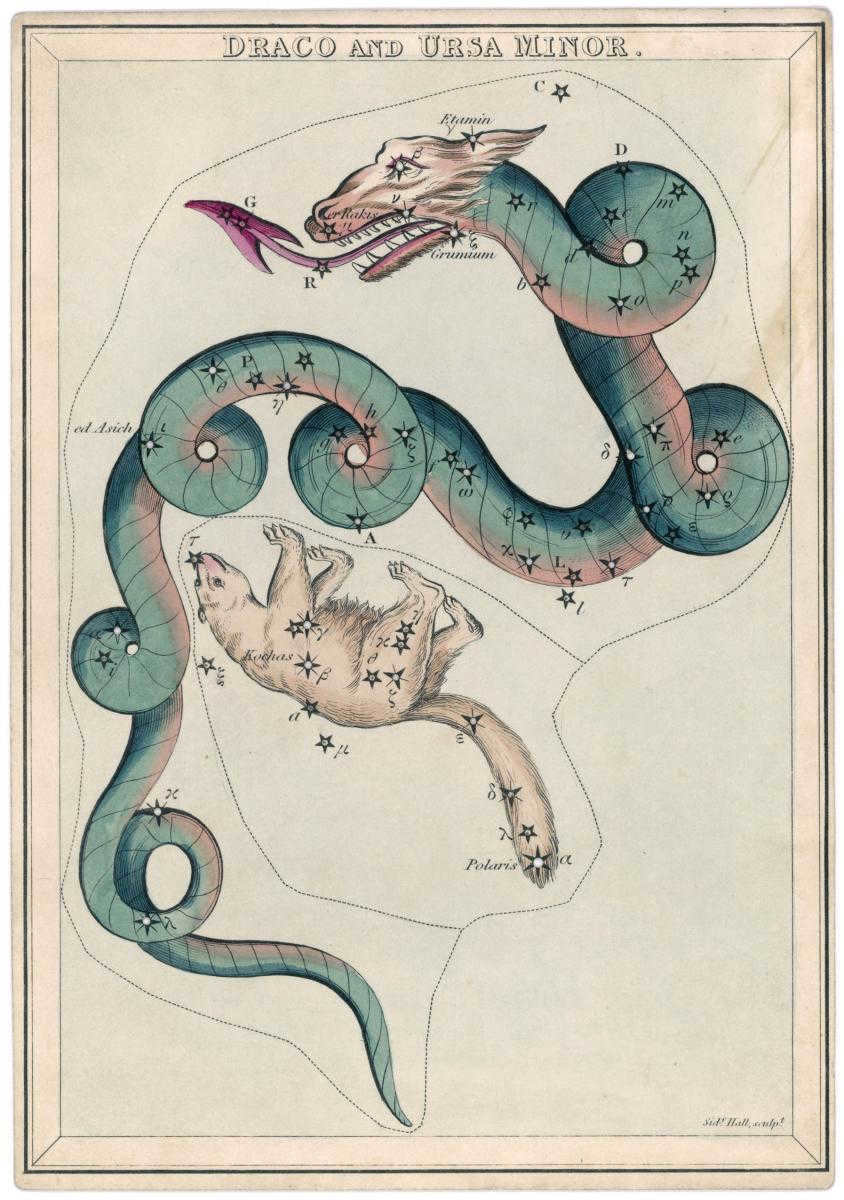
Photo: Mary Evans Picture Library/globallookpress.com
How did the Dragon come to be in the sky? As the legend goes, the constellation represents Ladon the dragon. Ladon was placed by Hera in the garden of Hesperides, where he was tasked with guarding the golden apples. During the process of retrieving the precious fruit, Heracles slew Ladon. In gratitude for the dragon’s service, Hera settled him in the heavens.
Lyra
Lyra is a constellation located under the head of the Dragon. It has a shape that resembles a ladle. The tail of the dipper is adorned by the star Vega, which is the second brightest star in the Northern Hemisphere. It is only surpassed by Arcturus, the fourth brightest star in the sky. Lyra can be best observed during the summer months, but it is also visible from May to October.
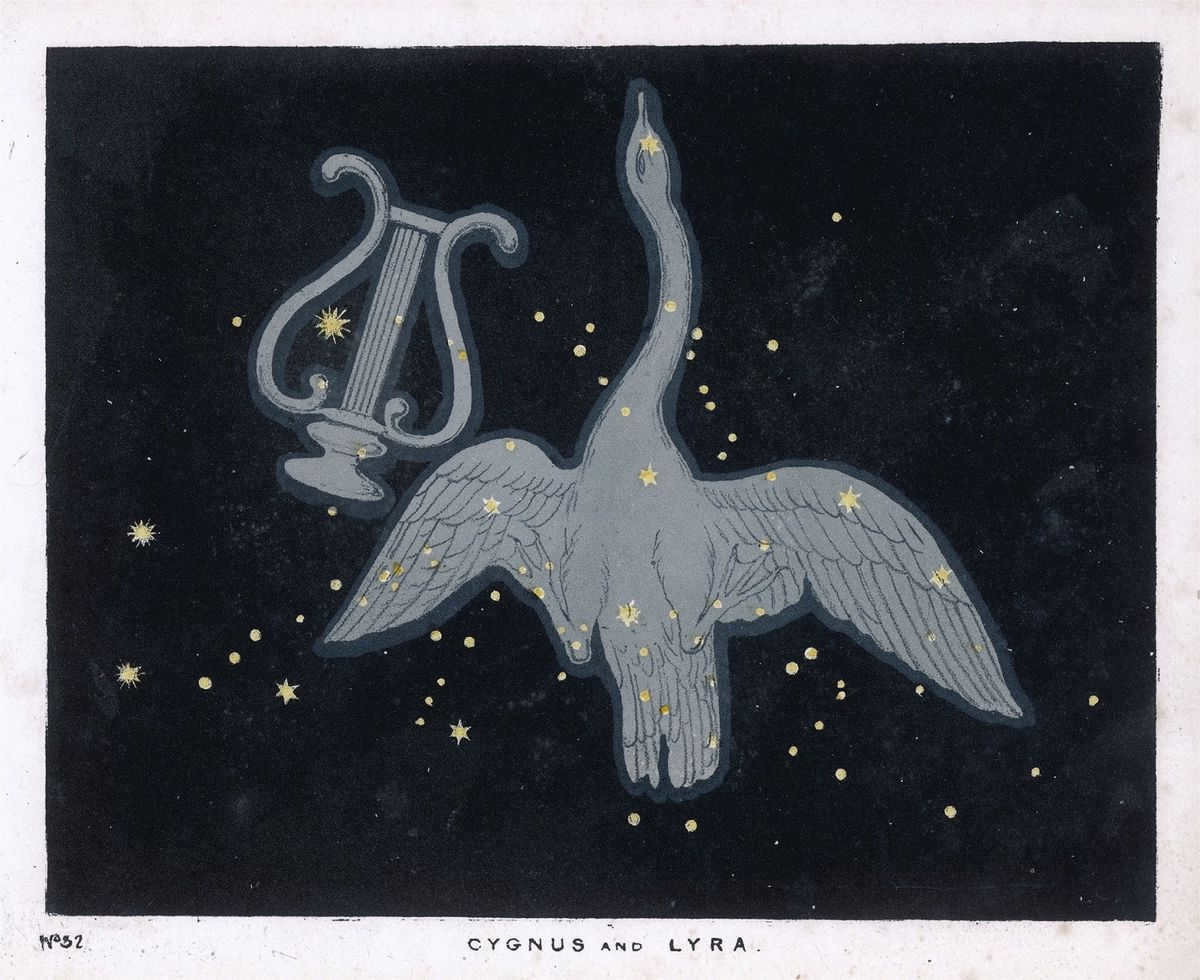
There are numerous tales surrounding the appearance of the constellation in the celestial sphere. One story claims that Lyra represents the kite of Zeus, which was placed in the sky as a reward for assisting in the rescue of a nymph from the clutches of an evil Titan. However, an alternative theory suggests that Lyra is a celestial representation of the musical instrument with the same name, once owned by Orpheus or Apollo. The gods elevated the golden lyre to the heavens so that it could continue to enchant humanity with its visual and auditory splendor.
The constellation Orion is renowned for its distinctive belt, consisting of three stars aligned in a row. To fully appreciate Orion, one must gaze both above and below the belt. The ultimate celestial markers are Betelgeuse and Rigel, two stars that hold a place among the most brilliant in the entire world. In Russia, autumn is the prime season for observing Orion.
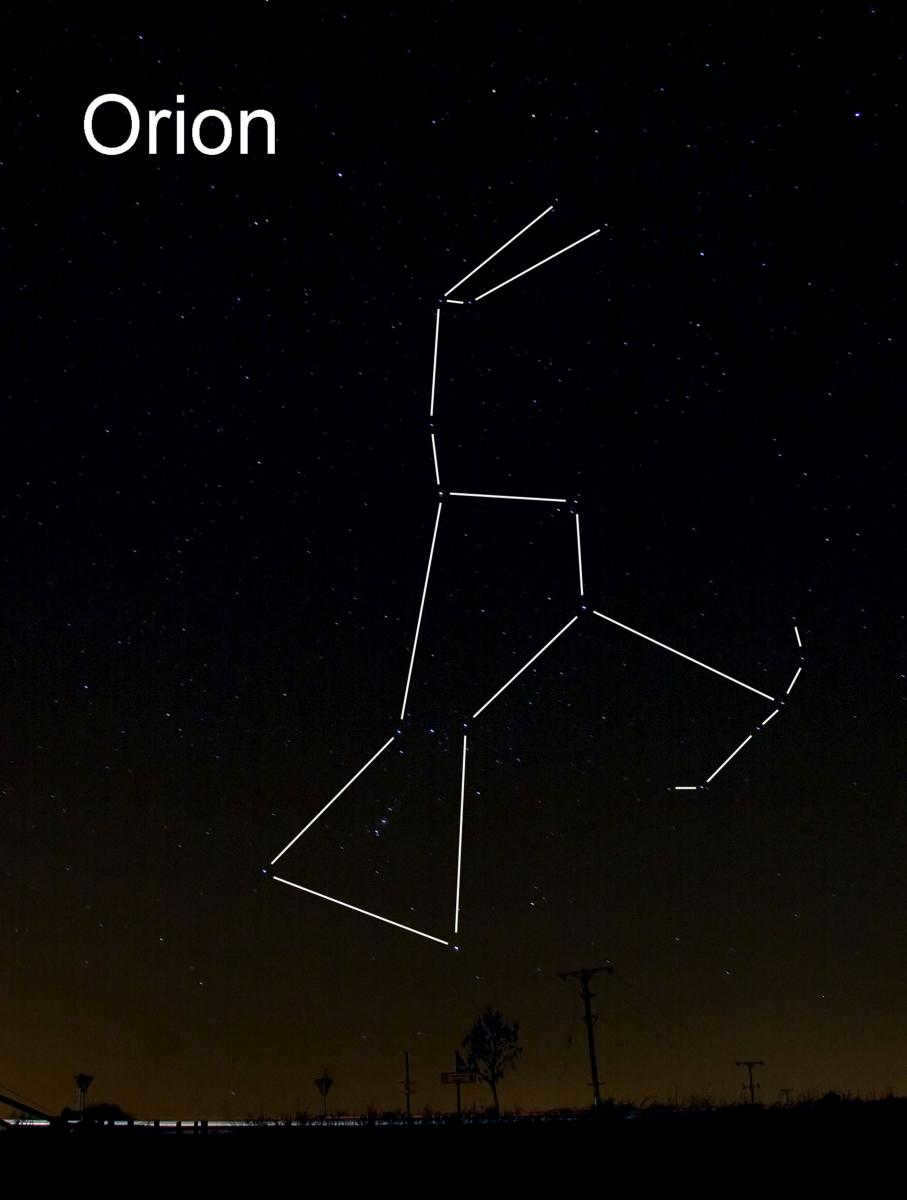
Image Credit: Jamie Cooper/ASTD0
Legends abound regarding the appearance of the Orion constellation in the night sky. The exact origin of this constellation remains a mystery. One tale suggests that Orion fell in love with the seven Pleiades, a group of nymph sisters. In his pursuit of their affections, Zeus intervened and relocated the Pleiades to the Taurus constellation in the sky. To this day, Orion continues his search for his lost love. Another legend tells of Orion’s battle with a bull, representing the Taurus constellation. However, it was ultimately the sting of a scorpion that proved fatal for the hunter. This is said to be the reason why Orion sets in the West, as if hiding from the Scorpio constellation.
Cassiopeia
Cassiopeia is a constellation in the northern sky. It is named after the queen Cassiopeia in Greek mythology. The constellation is easily recognizable due to its distinctive “W” shape. Cassiopeia is visible all year round from the northern hemisphere and is one of the 48 constellations listed by the 2nd-century astronomer Ptolemy. It is located near the celestial pole, which means it never sets below the horizon. Cassiopeia is known for its many bright stars, including the famous supernova remnant known as Cassiopeia A. It is also home to several deep-sky objects, such as the open clusters M52 and M103, and the emission nebula IC 63. Overall, Cassiopeia is a fascinating constellation to observe and study.
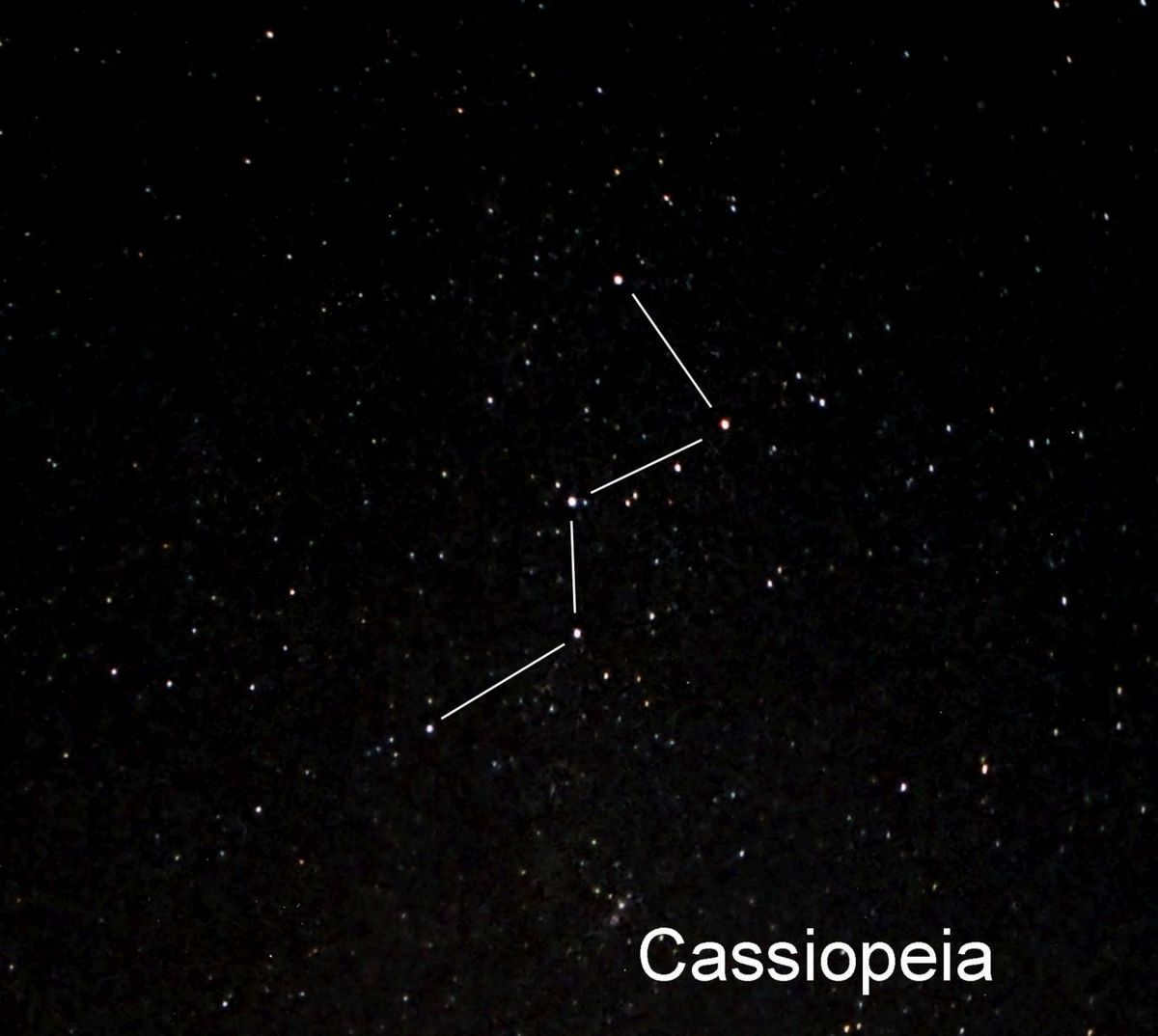
The approximate location of Cassiopeia is in close proximity to the Dragon. However, now it is necessary to locate Polaris – the tip of the Little Bear’s tail. The configuration of Cassiopeia resembles either the letters M or W, depending on one’s perspective. Similar to the Dragon, Cassiopeia can be seen throughout the year, but it is particularly prominent during the autumn season.
Andromeda Galaxy
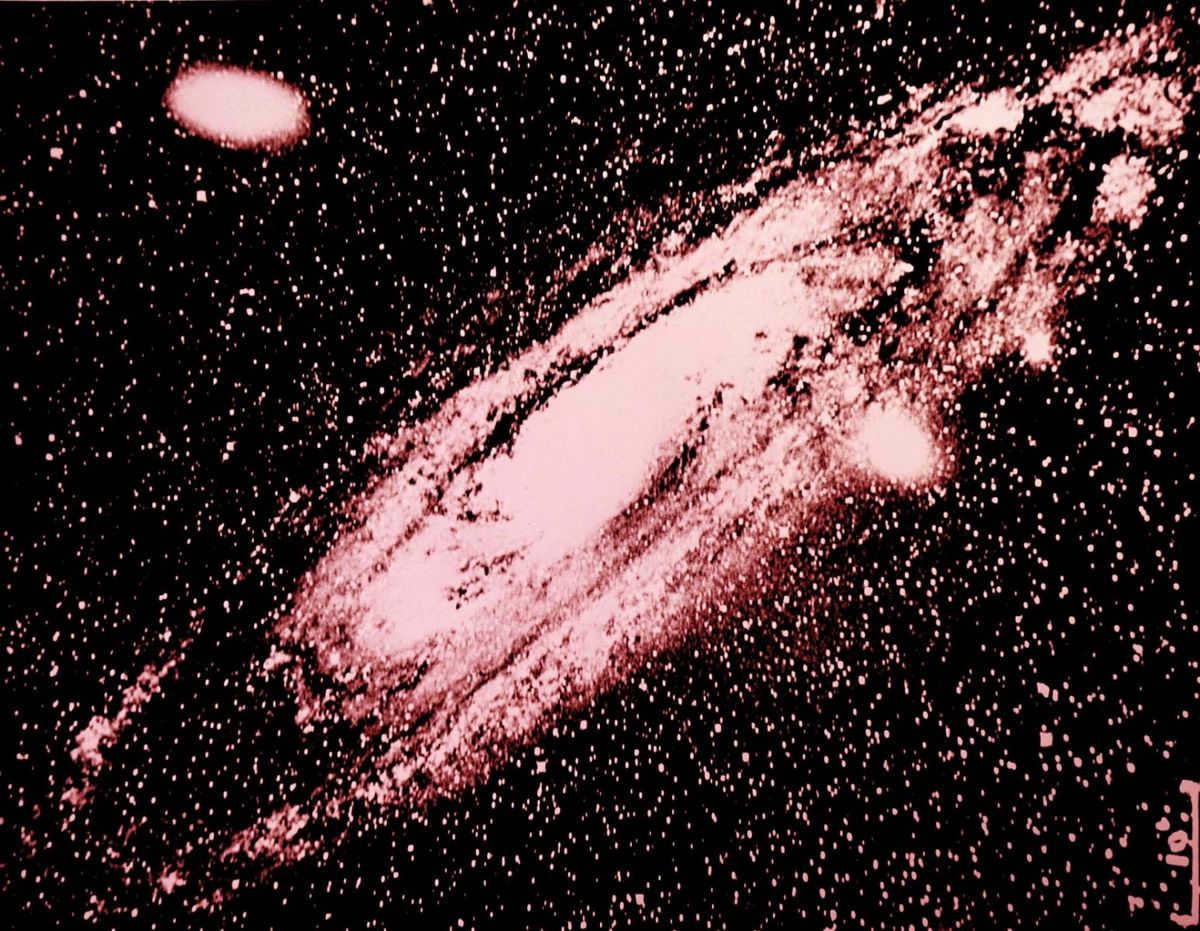
Photo: Global Look Press
Andromeda lies beneath Cassiopeia. To locate it, you must first locate a large square in the sky. The top star and the two stars at the bottom of the square are part of the Pegasus Pleiad. The upper left star, however, represents the head of Andromeda. From this star, a chain of three stars extends to the left and upwards. From the second star, counting from the head, chains of stars extend in different directions – these represent the arms. Similarly, from the third star, a shorter chain extends – representing the leg of the girl.
Perseus
The constellation Perseus is adjacent to Andromeda and Cassiopeia. It is situated between them, but positioned below both. A prominent star in the constellation is Mirach, which emits chains of stars in various directions. Mirach represents the middle of Perseus’ torso. The upward chain corresponds to the upper part of the torso and the hero’s head. The sideways chain represents the hand in which Perseus holds the head of Medusa Gorgon. If you look down from Mirach, you will once again observe two chains of stars, with the first representing the hero’s leg and the second (shorter) symbolizing the shield bestowed upon Perseus.

Cepheus
To locate Cepheus, one must trace a straight line from Polaris to Cassiopeia and look upwards. Alternatively, one can gaze above the point where the tail of the Dragon bends. This constellation takes the shape of a house and is most visible between the months of August and September.
All four constellations – Cassiopeia, Andromeda, Perseus, and Cepheus – are connected through a captivating tale:





